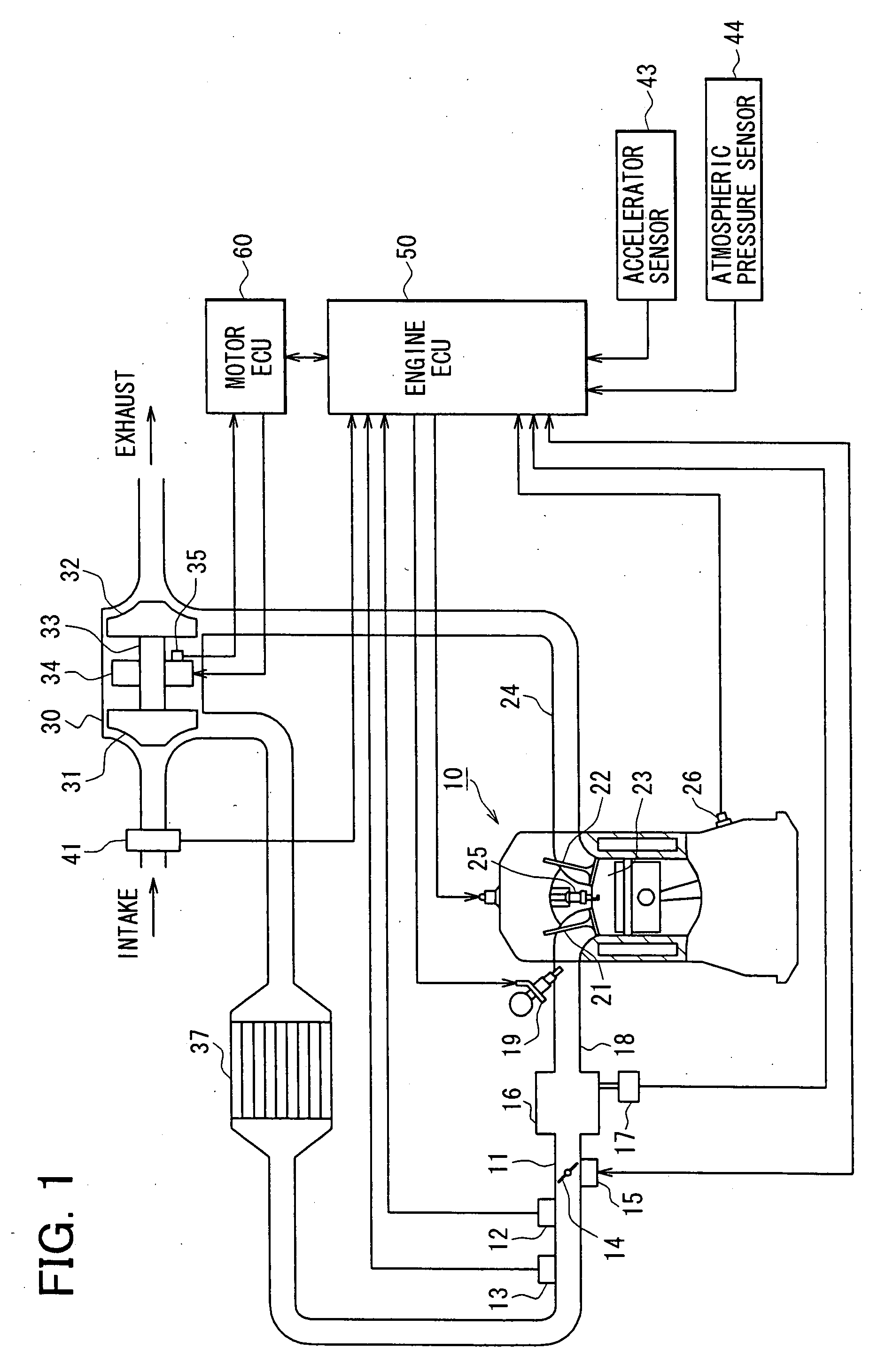Controller for internal combustion engine with supercharger
a technology of internal combustion engine and controller, which is applied in the direction of electrical control, process and machine control, instruments, etc., can solve problems such as delay in control, and achieve the effects of improving drivability, fuel consumption, and supercharger power
- Summary
- Abstract
- Description
- Claims
- Application Information
AI Technical Summary
Benefits of technology
Problems solved by technology
Method used
Image
Examples
first embodiment
[0047] An embodiment of the present invention will be described below with reference to the drawings. In the embodiment, an engine control system is constructed for an on-vehicle multi-cylinder gasoline engine as an internal combustion engine, and the engine of the control system is provided with an electrically-assisted turbocharger (hereinbelow, also called electric turbocharger) as a supercharger. First, a general schematic configuration diagram of an engine control system will be described with reference to FIG. 1.
[0048] In an engine 10 shown in FIG. 1, an intake pipe 11 is provided with a throttle valve 14 as air amount adjusting means whose position is adjusted by a throttle actuator 15 such as a DC motor or the like. The throttle actuator 15 has therein a throttle position sensor for detecting the throttle position. On the upstream side of the throttle valve 14, a boost pressure sensor 12 for detecting pressure on the throttle upstream side (boost pressure generated by a tur...
second embodiment
[0129]FIG. 18 is a general schematic configuration diagram of an engine control system. The same reference numerals are designated to the same components as those of the first embodiment and the description will not be repeated. The description of the same operations will not be also repeated.
[0130] In the intake pipe 11, an auxiliary electric compressor 38 is provided on the compressor upstream side of the turbocharger 30. By the auxiliary compressor 38, the intake air is compressed on the upstream side of the turbocharger 30. The auxiliary compressor 38 uses a motor 38a as a drive source. When the motor 38a is driven by power supply from a battery (not shown), the auxiliary compressor 38 operates. That is, different from the turbocharger 30, the auxiliary compressor 38 uses power other than exhaust as its power source.
[0131] The engine ECU 50 determines a control amount of the auxiliary compressor 38 (motor 38a) interlockingly with the torque base control. Consequently, when the...
third embodiment
[0175]FIG. 30 is a general schematic configuration diagram of an engine control system.
[0176] In an engine 210 shown in FIG. 30, a piston 212 is housed in a cylinder block 211, and a combustion chamber 214 is defined by the cylinder inner walls, the piston 212, and a cylinder head 213. In the cylinder head 213, an electrically-controlled fuel injection valve 215 is disposed. A high-pressure fuel is supplied from a common rail 216 to the fuel injection valve 215, and the fuel is injected into the combustion chamber 214 by an opening operation of the fuel injection valve 215. Although not shown, the system has a fuel pump for pressure-feeding the fuel in a fuel tank to the common rail 216. A fuel discharge amount of the fuel pump is controlled on the basis of a pressure (fuel pressure) in the common rail detected by a sensor or the like.
[0177] An intake valve 217 is disposed for an intake port, and an exhaust valve 218 is disposed for an exhaust port. An exhaust pipe 221 is connecte...
PUM
 Login to View More
Login to View More Abstract
Description
Claims
Application Information
 Login to View More
Login to View More - R&D
- Intellectual Property
- Life Sciences
- Materials
- Tech Scout
- Unparalleled Data Quality
- Higher Quality Content
- 60% Fewer Hallucinations
Browse by: Latest US Patents, China's latest patents, Technical Efficacy Thesaurus, Application Domain, Technology Topic, Popular Technical Reports.
© 2025 PatSnap. All rights reserved.Legal|Privacy policy|Modern Slavery Act Transparency Statement|Sitemap|About US| Contact US: help@patsnap.com



